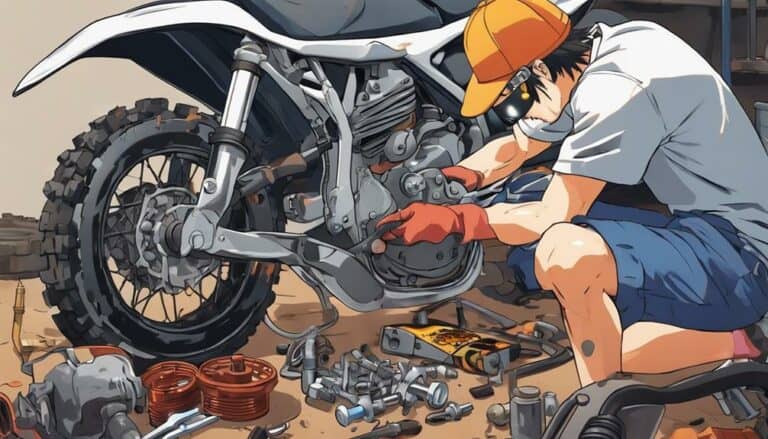When it comes to draining dirt bike oil, have you ever found yourself struggling to do it cleanly and efficiently?
Imagine a method that could simplify the process and save you time and hassle.
Well, what if there was a tool that could revolutionize how you change your oil, making the whole experience smoother and mess-free?
Let's explore a technique that might just change the way you maintain your dirt bike.
Key Takeaways
- Warm up the engine and locate the drain plug for efficient oil drainage.
- Use proper tools like a socket wrench and drain pan to remove and drain the old oil.
- Dispose of the old oil responsibly by recycling or using designated facilities.
- Follow steps carefully to ensure complete oil drainage and successful dirt bike maintenance.
Gather Necessary Tools and Supplies
To begin the process of draining dirt bike oil, make sure you have all the necessary tools and supplies ready for the oil change. The essential items you need for the oil drain include:
- Quality oil suitable for dirt bikes
- An oil filter and filter wrench
- A drain pan
- A funnel or pour spout
- A socket and box wrench set
- Clean rags with nitrile gloves
Quality oil guarantees peak performance of your dirt bike after the oil change. The oil filter and filter wrench are vital for replacing the old filter to maintain the cleanliness of the engine. A drain pan, funnel, or pour spout is necessary to collect and dispose of the old oil properly, preventing environmental contamination. The socket and box wrench set are required to effectively remove the drain plug on the dirt bike, allowing the old oil to be drained efficiently. Clean rags and nitrile gloves are essential for keeping your work area clean and safeguarding your hands during the oil change process.
Prepare Your Dirt Bike for Draining
Make sure the dirt bike is positioned on a level surface to facilitate proper oil drainage before moving on to the next steps. This step is important to guarantee all the old oil can be drained effectively without any spills or mess.
- Warm up the engine: By running the engine for a few minutes, you help the oil become less viscous, allowing it to flow out more smoothly during the draining process.
- Locate the drain plug: This essential component is typically situated on the bottom of the engine crankcase. Identifying it beforehand will make the draining process more efficient.
- Prepare the oil drain pan: Position the oil drain pan directly underneath the drain plug. This will catch the old oil as it flows out, preventing any spills and making cleanup easier once the draining is complete.
Locate the Drain Plug
The drain plug on dirt bikes can typically be found on the underside of the engine or crankcase. It is essential to locate this plug accurately to drain the old oil and replace it with fresh oil. Below is a table to help you identify where the drain plug might be located on your dirt bike model:
| Dirt Bike Brand | Drain Plug Location |
|---|---|
| Brand A | Bottom of engine |
| Brand B | Side of crankcase |
| Brand C | Near exhaust pipe |
To locate the drain plug on your specific dirt bike, consult the owner's manual or service guide. Once you have identified the drain plug's location, you may need a socket wrench or box wrench to remove it. Remember always to let the engine cool down before attempting to remove the drain plug to prevent any burns or injuries. Once you have successfully located and removed the drain plug, you can proceed to drain the old oil and prepare for refilling with fresh oil.
Drain the Oil From Your Dirt Bike
Begin the oil draining process on your dirt bike by using a socket wrench to remove the drain plug from the crankcase. Once you have the necessary tools ready, follow these steps to efficiently drain the oil from your dirt bike:
- Position a drain pan or container beneath the bike to catch the draining oil.
- Make sure the old oil to completely drain out of the bike's engine.
- Confirm the oil is fully drained before replacing the drain plug.
Properly Dispose of the Old Oil
To properly dispose of the old oil from your dirt bike, consider recycling centers or auto parts stores for environmentally safe disposal. Avoid pouring old oil down the drain, as it can contaminate water sources and harm wildlife. Check local regulations for designated collection points or hazardous waste disposal facilities to dispose of old oil safely. Reuse oil containers or jugs for storing and transporting used oil to a disposal site. Utilize oil change facilities that offer oil recycling services to guarantee responsible disposal of used oil.
| Disposal Method | Description | Benefits |
|---|---|---|
| Recycling Centers | Accept used oil for safe disposal | Prevent environmental harm |
| Auto Parts Stores | Offer disposal services for old oil | Ensure proper recycling |
| Local Collection Sites | Provide designated points for oil disposal | Follow local regulations |
| Hazardous Waste Facilities | Dispose of oil in compliance with safety guidelines | Prevent harm to the environment |
| Reuse Containers | Use oil containers for transporting old oil | Reduce waste and pollution |
Conclusion
In summary, draining dirt bike oil is a vital maintenance task that can be easily done with the right tools and knowledge.
Did you know that regular oil changes can increase the lifespan of your dirt bike by up to 50%?
By following these steps, you can guarantee your bike runs smoothly and efficiently for years to come.
Don't overlook the importance of proper oil maintenance for your bike's performance and longevity.

